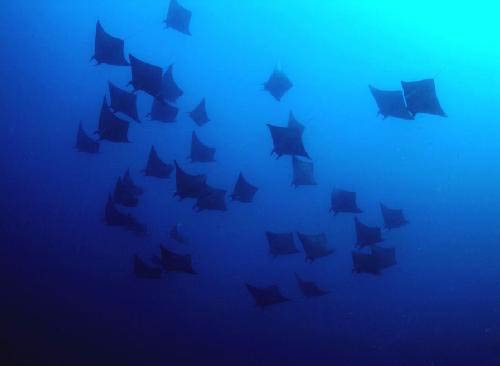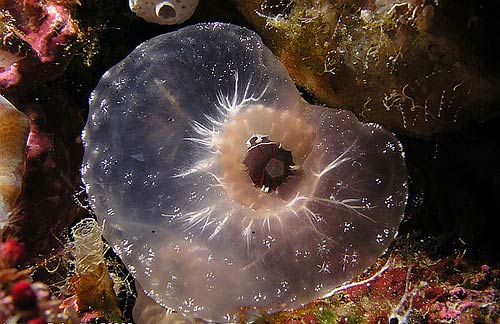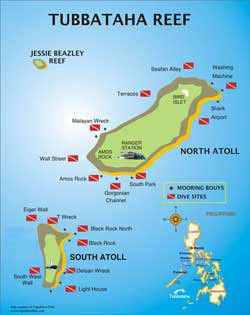Philippines Diving
Philippines Dive Regions
- Mindoro & Luzon
- North Palawan
- Visayas
- Tubbataha Reefs
Philippines Diving
Tubbataha Reefs
Tubbataha Reefs Natural Park

In the center of the Sulu Sea lies the Tubbataha Reef National Marine Park. Declared ...

In the center of the Sulu Sea lies the Tubbataha Reef National Marine Park. Declared a World Heritage site by the World Conservation Union in 1993, the park is composed of 2 coral atolls seperated by an 8 km (5 mile) wide channel.
These picturesque tropical atolls, known as North and South Tubbataha, host an amazing variety of reef tropicals, turtles and large pelagics. Manta and Eagle rays, white and black tip reef sharks,nurse, shovelnose, leopard and hammerhead sharks are common. Schools of jacks and snappers congregate on the wall. While sleek barracudas patrol.
Terrain ranges from gentle slope to sheer walls in excess of 914 meters(3000ft)! The spectacular explosion of life and color make diving the Tubbataha Reef an experience not to miss.
Tubbataha Reefs Natural Park is home to some of the most beautiful coral reefs in the world. Rising from the volcanic depths of the Sulu Sea in the western Philippines, these magnificent atolls encompass an astonishing diversity of marine life.
The park is an underwater sanctuary where nature can thrive. Tubbataha is the Philippines' only National Marine Park and is also a UNESCO World Heritage Site, a place of global importance, being preserved for generations to come.
From majestic whale sharks to elusive seahorses - Tubbataha supports an unparalleled variety of marine creatures. Colourful reef fish crowd corals growing in the shallows while sharks and manta rays haunt the steep drop offs to the open sea.
A team of rangers are stationed on the reef year-round and, from March until June, divers visit Tubbataha to experience the wonders of this unique underwater world.
Sulu Sea

A dive destination in the "massively exciting" range, diving the Sulu Sea is only accessible ...

A dive destination in the "massively exciting" range, diving the Sulu Sea is only accessible from liveaboards between mid Mar - early Jun. Most liveaboards depart from the capital of Palawan, Puerto Princessa, though at the beginning of the season it is possible to join cruises departing from Puerto Galera, Cebu and other Philippine harbours.
The primary dive sites are Tubbataha, Jessie Beazley and Basterra Reefs, approximately 180 km southeast of Puerto Princessa. Other dive sites visited by the liveaboards are Bancoran Island, Arena Island, Cavili Island and Calusa Island. Approximately 1500 divers annually visit the Sulu Sea's dive sites, generating around US$1,000,000 for The Philippine's economy.
Protected within the borders of the 33,200ha Tubbataha Reef National Marine Park, gazetted on 11 August 1988 and declared a UNESCO world heritage site in 1993, are some of the World's greatest formations of oceanic atolls and platform reefs. Comprising the only two atolls in the Philippine archipelago, North and South Islets and their accompanying reefs, underwater topography features gradual slopes to vertical walls dropping up to 100 meters. Visibility ranges from 15-40m.Separated from its northern counterpart by an 8km wide channel, South Reef, a small, triangular-shaped reef about 1-2km wide, is another shallow platform enclosing a sandy lagoon. South Islet, a coralline-sand cay of approximately 800m2, is located on the southern tip of the reef.
Forty six bird species have been recorded on the islets of Tubbataha while underwater a high diversity of fish has been recorded with 379 species in at least 40 families. Sightings of Black-tip Shark, White-tip Shark, huge Manta Rays (one 6m wingspan regular visitor, known as lquote The Old Man Of The Sea quote , is easily identified by the remnants of an anchor rope buried into his wing) and Eagle Rays are common. Tridacnid clams such as Crocus Clam, Giant Clam, Scaly Clam and Horse's Hoof (or Bear Paw) Clam are found in the lagoons.
 Tubbataha Reef
Tubbataha Reef
Tubbataha Reef escaped much of the damage caused by the warm water bleaching event of 1998. A survey in 2000 revealed that though living branching coral cover had declined overall, South Reef actually showed an increase in living coral cover. Physical damage from local human activities or storms was not apparent while fish diversity and abundance had increased. Both encouraging signs are factors of the protection the reserve has enjoyed. Fishing pressure is down while species diversity of Butterflyfish (popular aquarium fish), now up to 38 total, and the large size of the butterflyfish are evidence that collection for aquaria is also down. Consequently incidence of large marine life such as sharks, Humphead Wrasses, turtles, Manta Rays and schools of jacks have also increased.
Jessie Beazley
Jessie Beazley Reef rises almost to the surface with the reef top gradually sloping down to 7-12m before dropping over the wall. Predominantly the shallows are covered with Porites, Acropora and Sarcophyton corals, and supports a teeming small fish population. Off the walls into the free ocean Hammerhead, Mako and Thresher Sharks are known to cruise by. Characterised by huge Gorgonians, Black Corals, soft tree corals and huge Basket Sponges up to 3m across, the crevices, cracks, ledges and small overhangs in the walls are ideal territory for colonies of lobsters and dozing turtles. White-tip, Black-tip and Grey Reef Sharks, Napoleon Wrasse, large groupers, tuna and barracuda hunt along the walls and there are large shoals of fish such as Midnight, Black and White Snappers; Vlaming quote s Unicornfish; Royal, Emperor and Yellowmask Angelfish; Dusky, Longnose, Chevron, Blackback, Lined and Racoon Butterflyfish; batfish; Spotted and Lined Sweetlips; pennantfish; and every type of triggerfish known in Philippine waters.



